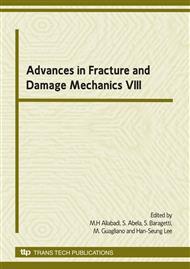p.845
p.849
p.853
p.857
p.861
p.865
p.869
p.873
p.877
Damage Investigation and Design of Woven Composite Bonded Joint
Abstract:
Non-plane joints, such as T-joints, L-joints and shaped joint can bring enormous potential benefits from the reduction of the fastener and the part count, which lead to the dramatic decrease of assemble cost and primary structural weight in composite structures. To understand the mechanistic character of the joint, a 3-D finite element analysis model is established by means of software ABAQUS. The stresses on ply level and the predictions on the damage onset of 3-D woven composite π joint under tensile load are obtained. Numerical results agree well with empirical data. The effects of structural geometry parameters, such as support length, support thickness and radius of the corner, are also discussed. Results illustrated that increasing the thickness of L preform or filler radius can improve the strength of woven composite π joint effectively.
Info:
Periodical:
Pages:
861-864
Citation:
Online since:
October 2009
Authors:
Price:
Сopyright:
© 2010 Trans Tech Publications Ltd. All Rights Reserved
Share:
Citation:


